Particle identification for neutron rich nuclei ⁶³⁶⁵Cr from knockout reactions
This paper presents the identification for 63,65Cr isotopes as the products of knockout
reactions for the first time, measured at RIKEN, Japan, within the framework of the “Shell Evolution
And Search for Two-plus energies At RIBF” (RIBF- Radioactive Isotope Beam Factory) project, in
short SEASTAR. Based on the Bρ-ΔE-ToF method, these nuclei were well separated. The results will
be used in the spectroscopic study on 63,65Cr contributing data to the structural study around the N=40
“island of inversion”.
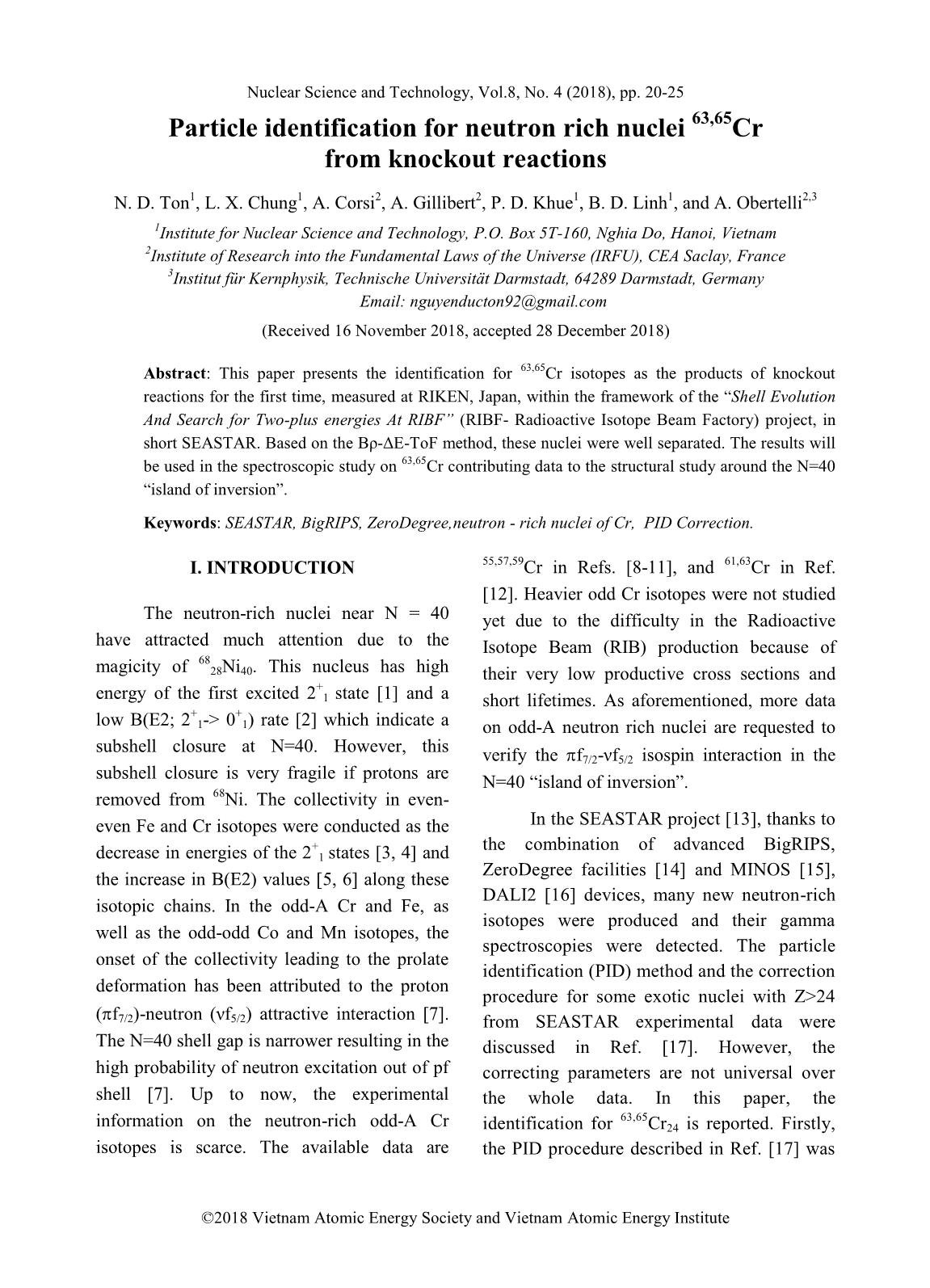
Trang 1
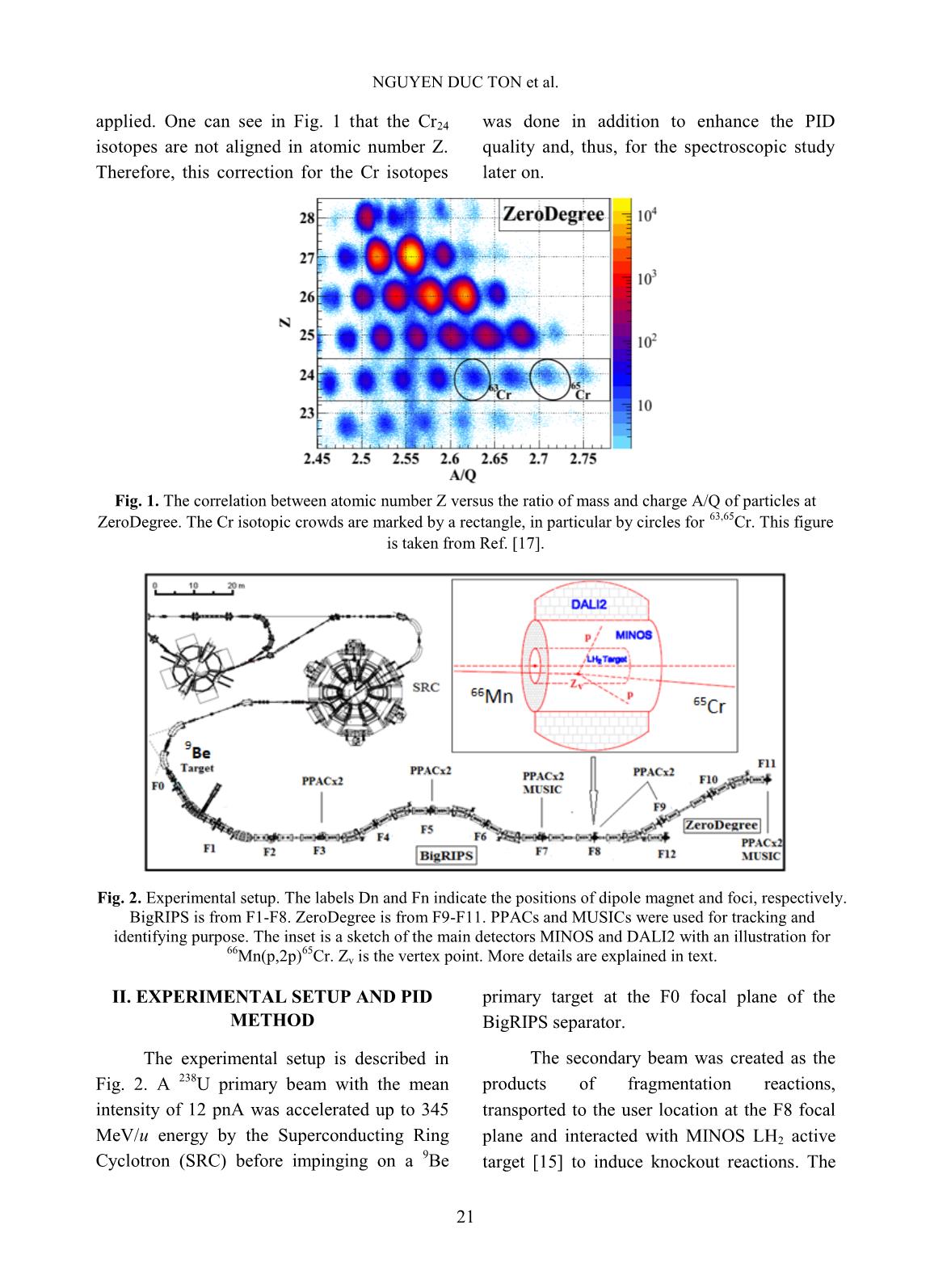
Trang 2
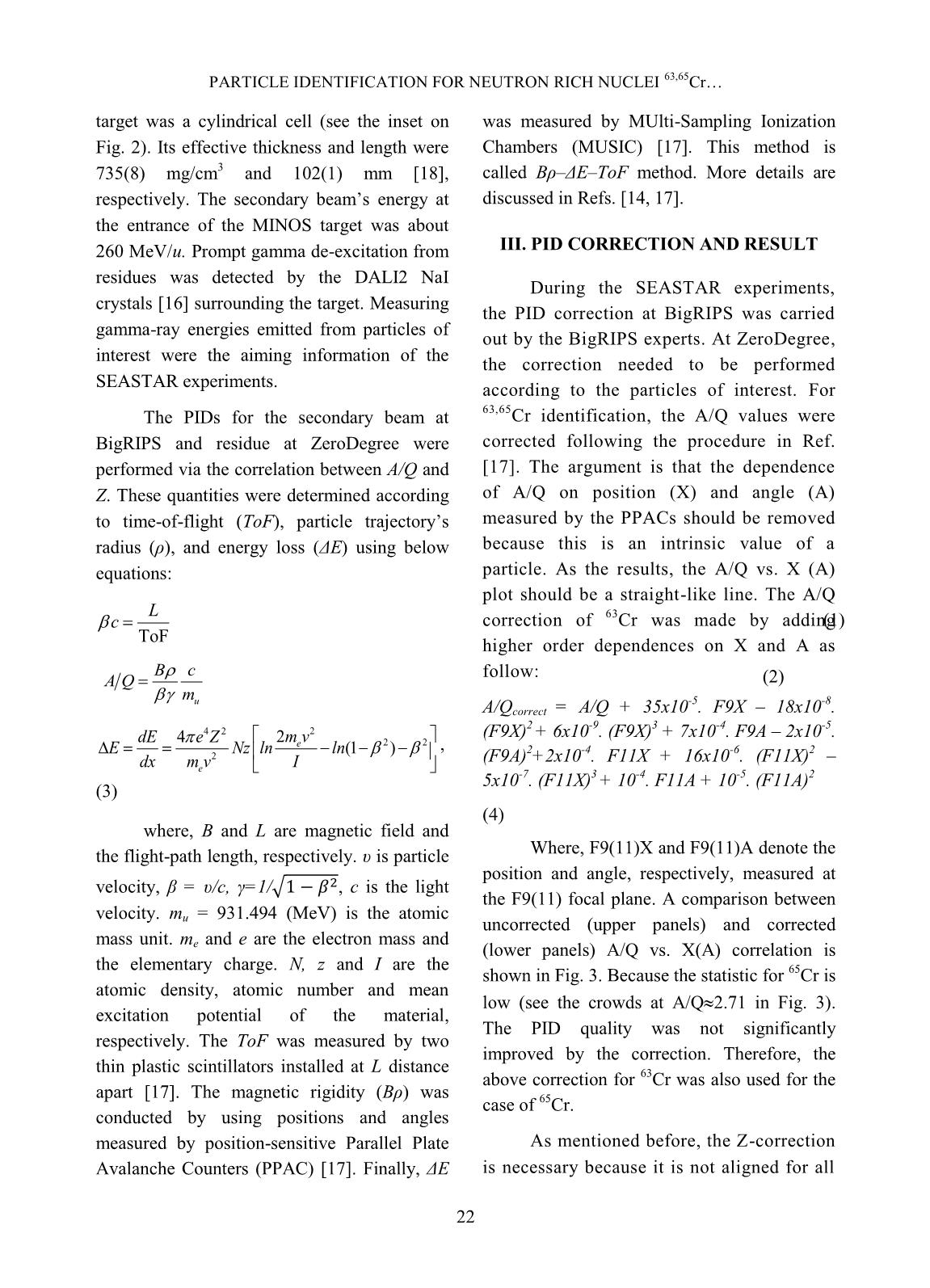
Trang 3
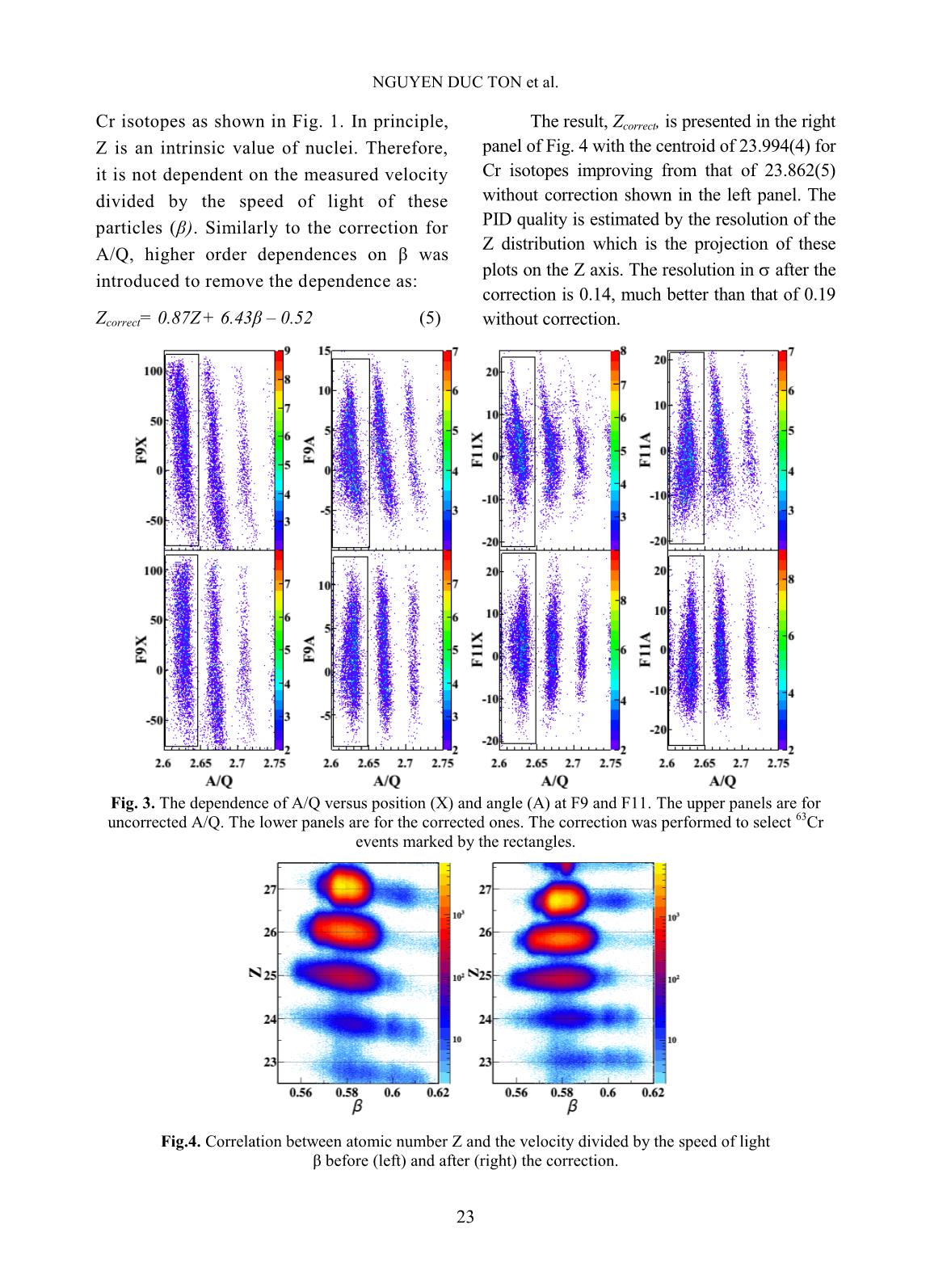
Trang 4
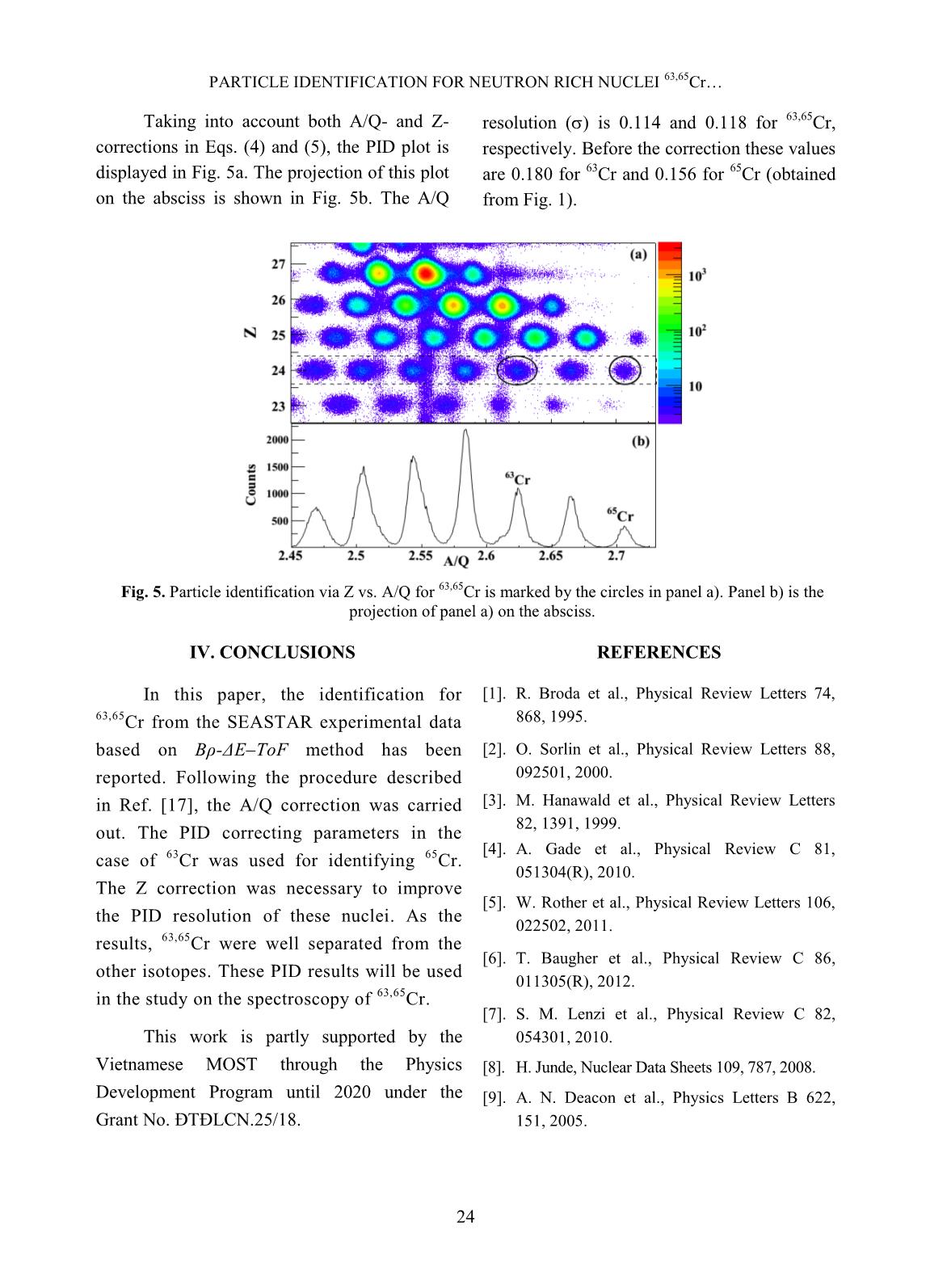
Trang 5
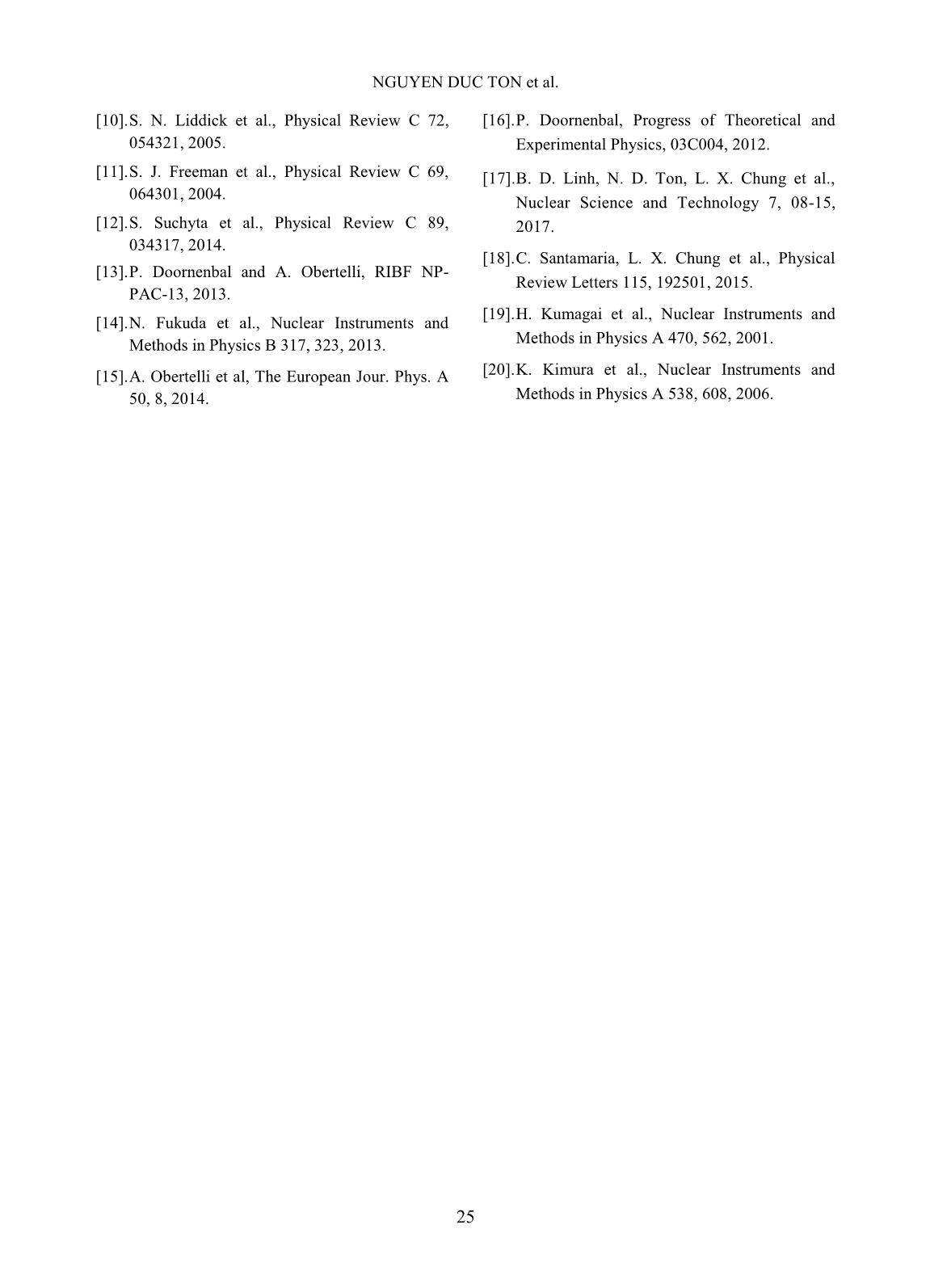
Trang 6
Bạn đang xem tài liệu "Particle identification for neutron rich nuclei ⁶³⁶⁵Cr from knockout reactions", để tải tài liệu gốc về máy hãy click vào nút Download ở trên
Tóm tắt nội dung tài liệu: Particle identification for neutron rich nuclei ⁶³⁶⁵Cr from knockout reactions
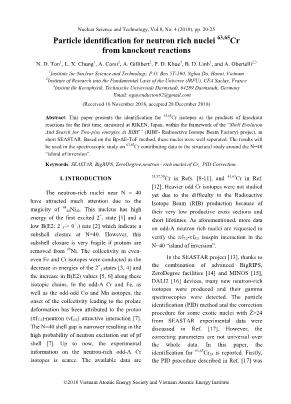
Nuclear Science and Technology, Vol.8, No. 4 (2018), pp. 20-25 Particle identification for neutron rich nuclei 63,65Cr from knockout reactions N. D. Ton1, L. X. Chung1, A. Corsi2, A. Gillibert2, P. D. Khue1, B. D. Linh1, and A. Obertelli2,3 1Institute for Nuclear Science and Technology, P.O. Box 5T-160, Nghia Do, Hanoi, Vietnam 2Institute of Research into the Fundamental Laws of the Universe (IRFU), CEA Saclay, France 3Institut für Kernphysik, Technische Universität Darmstadt, 64289 Darmstadt, Germany Email: nguyenducton92@gmail.com (Received 16 November 2018, accepted 28 December 2018) Abstract: This paper presents the identification for 63,65Cr isotopes as the products of knockout reactions for the first time, measured at RIKEN, Japan, within the framework of the “Shell Evolution And Search for Two-plus energies At RIBF” (RIBF- Radioactive Isotope Beam Factory) project, in short SEASTAR. Based on the Bρ-ΔE-ToF method, these nuclei were well separated. The results will be used in the spectroscopic study on 63,65Cr contributing data to the structural study around the N=40 “island of inversion”. Keywords: SEASTAR, BigRIPS, ZeroDegree,neutron - rich nuclei of Cr, PID Correction. I. INTRODUCTION 55,57,59Cr in Refs. [8-11], and 61,63Cr in Ref. [12]. Heavier odd Cr isotopes were not studied The neutron-rich nuclei near N = 40 yet due to the difficulty in the Radioactive have attracted much attention due to the Isotope Beam (RIB) production because of 68 magicity of 28Ni40. This nucleus has high their very low productive cross sections and + energy of the first excited 2 1 state [1] and a short lifetimes. As aforementioned, more data + + low B(E2; 2 1-> 0 1) rate [2] which indicate a on odd-A neutron rich nuclei are requested to subshell closure at N=40. However, this verify the f7/2-νf5/2 isospin interaction in the subshell closure is very fragile if protons are N=40 “island of inversion”. removed from 68Ni. The collectivity in even- even Fe and Cr isotopes were conducted as the In the SEASTAR project [13], thanks to + the combination of advanced BigRIPS, decrease in energies of the 2 1 states [3, 4] and ZeroDegree facilities [14] and MINOS [15], the increase in B(E2) values [5, 6] along these DALI2 [16] devices, many new neutron-rich isotopic chains. In the odd-A Cr and Fe, as isotopes were produced and their gamma well as the odd-odd Co and Mn isotopes, the spectroscopies were detected. The particle onset of the collectivity leading to the prolate identification (PID) method and the correction deformation has been attributed to the proton procedure for some exotic nuclei with Z>24 ( f7/2)-neutron (νf5/2) attractive interaction [7]. from SEASTAR experimental data were The N=40 shell gap is narrower resulting in the discussed in Ref. [17]. However, the high probability of neutron excitation out of pf correcting parameters are not universal over shell [7]. Up to now, the experimental the whole data. In this paper, the 63,65 information on the neutron-rich odd-A Cr identification for Cr24 is reported. Firstly, isotopes is scarce. The available data are the PID procedure described in Ref. [17] was ©2018 Vietnam Atomic Energy Society and Vietnam Atomic Energy Institute NGUYEN DUC TON et al. applied. One can see in Fig. 1 that the Cr24 was done in addition to enhance the PID isotopes are not aligned in atomic number Z. quality and, thus, for the spectroscopic study Therefore, this correction for the Cr isotopes later on. Fig. 1. The correlation between atomic number Z versus the ratio of mass and charge A/Q of particles at ZeroDegree. The Cr isotopic crowds are marked by a rectangle, in particular by circles for 63,65Cr. This figure is taken from Ref. [17]. Fig. 2. Experimental setup. The labels Dn and Fn indicate the positions of dipole magnet and foci, respectively. BigRIPS is from F1-F8. ZeroDegree is from F9-F11. PPACs and MUSICs were used for tracking and identifying purpose. The inset is a sketch of the main detectors MINOS and DALI2 with an illustration for 66 65 Mn(p,2p) Cr. Zv is the vertex point. More details are explained in text. II. EXPERIMENTAL SETUP AND PID primary target at the F0 focal plane of the METHOD BigRIPS separator. The experimental setup is described in The secondary beam was created as the Fig. 2. A 238U primary beam with the mean products of fragmentation reactions, intensity of 12 pnA was accelerated up to 345 transported to the user location at the F8 focal MeV/u energy by the Superconducting Ring plane and interacted with MINOS LH2 active Cyclotron (SRC) before impinging on a 9Be target [15] to induce knockout reactions. The 21 PARTICLE IDENTIFICATION FOR NEUTRON RICH NUCLEI 63,65Cr target was a cylindrical cell (see the inset on was measured by MUlti-Sampling Ionization Fig. 2). Its effective thickness and length were Chambers (MUSIC) [17]. This method is 735(8) mg/cm3 and 102(1) mm [18], called Bρ–ΔE–ToF method. More details are respectively. The secondary beam’s energy at discussed in Refs. [14, 17]. the entrance of the MINOS target was about 260 MeV/u. Prompt gamma de-excitation from III. PID CORRECTION AND RESULT residues was detected by the DALI2 NaI During the SEASTAR experiments, crystals [16] surrounding the target. Measuring the PID correction at BigRIPS was carried gamma-ray energies emitted from particles of out by the BigRIPS experts. At ZeroDegree, interest were the aiming information of the the correction needed to be performed SEASTAR experiments. according to the particles of interest. For The PIDs for the secondary beam at 63,65Cr identification, the A/Q values were BigRIPS and residue at ZeroDegree were corrected following the procedure in Ref. performed via the correlation between A/Q and [17]. The argument is that the dependence Z. These quantities were determined according of A/Q on position (X) and angle (A) to time-of-flight (ToF), particle trajectory’s measured by the PPACs should be removed radius (ρ), and energy loss (ΔE) using below because this is an intrinsic value of a equations: particle. As the results, the A/Q vs. X (A) plot should be a straight-like line. The A/Q L 63 c correction of Cr was made by adding(1) ToF higher order dependences on X and A as Bc follow: AQ (2) mu -5 -8 A/Qcorrect = A/Q + 35x10 . F9X – 18x10 . 2 -9 3 -4 -5 42 2 (F9X) + 6x10 . (F9X) + 7x10 . F9A – 2x10 . dE 4 eZ 2mve 22 E Nz ln ln(1 ) , 2 -4 -6 2 2 (F9A) +2x10 . F11X + 16x10 . (F11X) – dx me v I 5x10-7. (F11X)3 + 10-4. F11A + 10-5. (F11A)2 (3) (4) where, B and L are magnetic field and the flight-path length, respectively. υ is particle Where, F9(11)X and F9(11)A denote the position and angle, respectively, measured at velocity, β = υ/c, γ=1/√ , c is the light the F9(11) focal plane. A comparison between velocity. m = 931.494 (MeV) is the atomic u uncorrected (upper panels) and corrected mass unit. m and e are the electron mass and e (lower panels) A/Q vs. X(A) correlation is the elementary charge. N, z and I are the shown in Fig. 3. Because the statistic for 65Cr is atomic density, atomic number and mean low (see the crowds at A/Q 2.71 in Fig. 3). excitation potential of the material, The PID quality was not significantly respectively. The ToF was measured by two improved by the correction. Therefore, the thin plastic scintillators installed at L distance above correction for 63Cr was also used for the apart [17]. The magnetic rigidity (Bρ) was case of 65Cr. conducted by using positions and angles measured by position-sensitive Parallel Plate As mentioned before, the Z-correction Avalanche Counters (PPAC) [17]. Finally, ΔE is necessary because it is not aligned for all 22 NGUYEN DUC TON et al. Cr isotopes as shown in Fig. 1. In principle, The result, Zcorrect, is presented in the right Z is an intrinsic value of nuclei. Therefore, panel of Fig. 4 with the centroid of 23.994(4) for it is not dependent on the measured velocity Cr isotopes improving from that of 23.862(5) divided by the speed of light of these without correction shown in the left panel. The particles (β). Similarly to the correction for PID quality is estimated by the resolution of the Z distribution which is the projection of these A/Q, higher order dependences on β was plots on the Z axis. The resolution in after the introduced to remove the dependence as: correction is 0.14, much better than that of 0.19 Zcorrect= 0.87Z + 6.43β – 0.52 (5) without correction. Fig. 3. The dependence of A/Q versus position (X) and angle (A) at F9 and F11. The upper panels are for uncorrected A/Q. The lower panels are for the corrected ones. The correction was performed to select 63Cr events marked by the rectangles. Fig.4. Correlation between atomic number Z and the velocity divided by the speed of light β before (left) and after (right) the correction. 23 PARTICLE IDENTIFICATION FOR NEUTRON RICH NUCLEI 63,65Cr Taking into account both A/Q- and Z- resolution () is 0.114 and 0.118 for 63,65Cr, corrections in Eqs. (4) and (5), the PID plot is respectively. Before the correction these values displayed in Fig. 5a. The projection of this plot are 0.180 for 63Cr and 0.156 for 65Cr (obtained on the absciss is shown in Fig. 5b. The A/Q from Fig. 1). Fig. 5. Particle identification via Z vs. A/Q for 63,65Cr is marked by the circles in panel a). Panel b) is the projection of panel a) on the absciss. IV. CONCLUSIONS REFERENCES In this paper, the identification for [1]. R. Broda et al., Physical Review Letters 74, 63,65Cr from the SEASTAR experimental data 868, 1995. based on Bρ-ΔE–ToF method has been [2]. O. Sorlin et al., Physical Review Letters 88, reported. Following the procedure described 092501, 2000. in Ref. [17], the A/Q correction was carried [3]. M. Hanawald et al., Physical Review Letters 82, 1391, 1999. out. The PID correcting parameters in the [4]. A. Gade et al., Physical Review C 81, case of 63Cr was used for identifying 65Cr. 051304(R), 2010. The Z correction was necessary to improve [5]. W. Rother et al., Physical Review Letters 106, the PID resolution of these nuclei. As the 022502, 2011. 63,65 results, Cr were well separated from the [6]. T. Baugher et al., Physical Review C 86, other isotopes. These PID results will be used 011305(R), 2012. 63,65 in the study on the spectroscopy of Cr. [7]. S. M. Lenzi et al., Physical Review C 82, This work is partly supported by the 054301, 2010. Vietnamese MOST through the Physics [8]. H. Junde, Nuclear Data Sheets 109, 787, 2008. Development Program until 2020 under the [9]. A. N. Deacon et al., Physics Letters B 622, Grant No. ÐTÐLCN.25/18. 151, 2005. 24 NGUYEN DUC TON et al. [10]. S. N. Liddick et al., Physical Review C 72, [16]. P. Doornenbal, Progress of Theoretical and 054321, 2005. Experimental Physics, 03C004, 2012. [11]. S. J. Freeman et al., Physical Review C 69, [17]. B. D. Linh, N. D. Ton, L. X. Chung et al., 064301, 2004. Nuclear Science and Technology 7, 08-15, [12]. S. Suchyta et al., Physical Review C 89, 2017. 034317, 2014. [18]. C. Santamaria, L. X. Chung et al., Physical [13]. P. Doornenbal and A. Obertelli, RIBF NP- Review Letters 115, 192501, 2015. PAC-13, 2013. [19]. H. Kumagai et al., Nuclear Instruments and [14]. N. Fukuda et al., Nuclear Instruments and Methods in Physics B 317, 323, 2013. Methods in Physics A 470, 562, 2001. [15]. A. Obertelli et al, The European Jour. Phys. A [20]. K. Kimura et al., Nuclear Instruments and 50, 8, 2014. Methods in Physics A 538, 608, 2006. 25
File đính kèm:
 particle_identification_for_neutron_rich_nuclei_cr_from_knoc.pdf
particle_identification_for_neutron_rich_nuclei_cr_from_knoc.pdf

